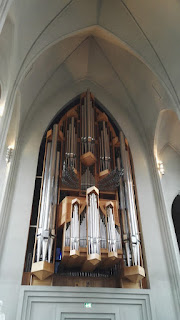Tein 30 tunnin
välipysähdyksen Reykjavikissa ja tämä antoi minulle mahdollisuuden muistella menneitä,
muinaista lomaani kyseisessä kaupungissa. Päätin siis käydä jälleen katsomassa
yhtä Reykjavikin maamerkeistä ei Hallgrímskirkjaa. Suureksi ilokseni saapuessani sinne huomasin, että puolen tunnin
kuluttua on alkamassa urkukonsertti, joka kuuluu Hallgrímskirkjan kansainvälisen urkukesän ohjelmistoon. Olin
edelliselläkin matkallani käynyt urkukesän konsertissa, joten päätin tietenkin
ostaa lipun tähänkin konserttiin ja vaikka esityksessä ei tällä kerralla ollut
laulua, niin päätin silti kirjoittaa siitä pienen jutun.
Hallgrímskirkjan urut ovat tunnetut ja
korkealaatuiset. Uruissa on 72 ääntä ja 5275 pilliä ja sen soittopöytä
uusittiin vuonna 2012 vastaamaan nykyajan vaatimuksia. Jokakesäisillä
festivaaleilla kirkossa esiintyy sekä islantilaisia että kansainvälisiä
tunnettuja muusikkoja.
Tässä konsertissa
urkuja soitti ranskalainen Thierry Escaich, joka on ollut Pariisin Saint-Ėtienne-du-Montin urkuri vuodesta 1997. Hän
on myös säveltäjä sekä opettaa improvisaatiota Pariisin konservatoriossa.
Konsertti alkoi Cėsar Franckin Pièce Heroȉque esityksellä teoksesta Trois Pièces. Kyseessä oli varsin dramaattinen esitys, joka oli ainakin minusta
todella kiehtova värikkyydessään. Seuraava kappale oli myöskin Franckilta
(Koraali 2). Teos alkoi surumielisenä, mutta päättyi viimeisiin toiveikkaisiin
nuotteihin. Todella kaunista.
Mutta konsertin
ehdoton helmi oli viimeinen esitys. Konsertin järjestäjät olivat antaneet
Escaichille hieman ennen konsertti vanhan virren sävelen, jota Escaich käytti
improvisaation pohjana. Aluksi hän soitti virren sävelen nuotti nuotilta ja
sitten alkoi itse improvisaatio-osuus. Ja millainen osuus! Olin aivan
haltioissani, miten upeaa musiikkia yksinkertaisesta sävellyksestä saa ajoiksi.
Escaich osoitti huikean improvisaatiokykynsä kieputtaessaan melodiaa ja
pyöriessään sen ympärillä urkujen koko kapasiteettia hyväksikäyttäen. Esitys
oli aivan käsittämättömän upea ja yleisö palkitsikin sen todella raikuvilla
aplodeilla.
Mikäli siis
satutte käymään Reykjavikissa joskus kesällä, niin kannattaa ehdottomasti
poiketa Hallgrímskirkjassa.
Hyvällä tuurilla siellä on juuri konsertti alkamassa ja vaikkei olisikaan, niin
kirkon tornista on mahtava näköala yli koko Reykjavikin.













